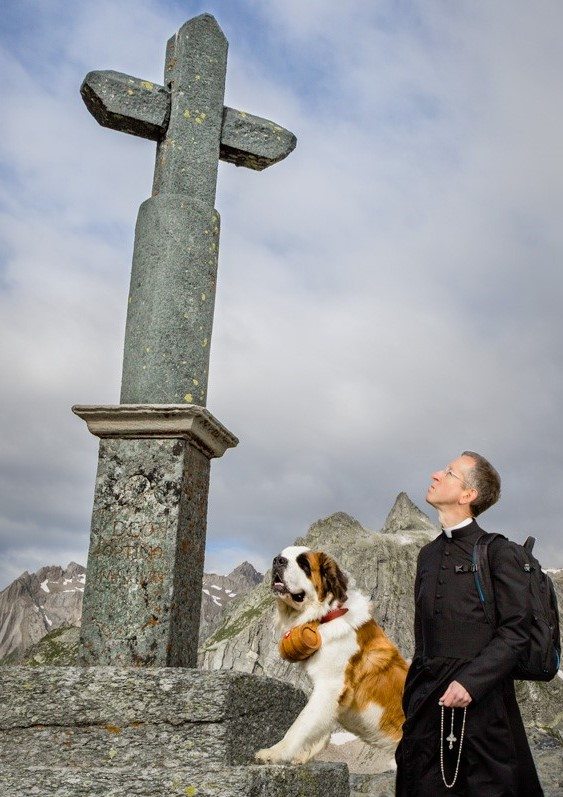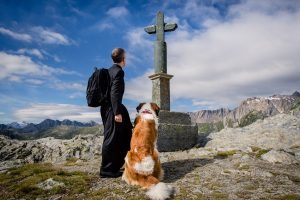Born to Rescue
The Saint-Dog, also known as the Saint Bernard, is the mascot of the Society of Ignatians because this four-legged hero, whose breed came into existence in order to be rescuers of pilgrims, vividly symbolizes why we exist and the virtues we aspire to embody.
The breed of the St. Bernard dog came into existence halfway to the heavens at 8000 feet, high amid the Swiss Alps, thanks to the dedicated group of priests and brothers at the Hospice of the Great Saint Bernard Pass. Founded by the heroic St. Bernard of Montjou in 1050, this community of men dedicated their lives to caring for pilgrims as they made their way through one of the great highways of Europe, the treacherous mountain pass that now bears the name of the saint.
The St. Bernard dogs assisted them in finding and rescuing travelers lost amid snow and mist, or amid massive avalanches; in dragging bodies out of snowdrifts; and in barking over limp bodies to attract the attention of the rescue team.
The result of a cross-breeding between a sheep dog and a bull dog they have the qualities of both: in head and chest they are decidedly bulldogish as well as in strength and toughness; in intelligence and loyalty they are decidedly true four-legged shepherds. Accustomed to cold weather for generations, they prefer to stay in outside kennels except for the most savagely cold winters. They became the rescue-dogs par excellence, able to to pick up a human scent from over two miles away, to find a body even underneath ten feet of snow and to carry heavy loads.
There were frequent casualties; indeed, almost to the point of extinction in the severe winters of 1816-1818.
The dogs became famous all over Europe. When Napoleon’s army crossed the Alps in 1800, they halted at the hospice where the exhausted soldiers were cared for by the priests and brothers. On departing the thankful soldiers shook hands with the members of the community and “embraced their dogs who caressed us as if they knew us”.
The most renowned individual of this universal symbol of bravery is Barry who has left a warm place in Swiss hearts and become Switzerland’s Superdog. In the course of his twelve years of action from 1800 -1812 he saved between 40 and 100 lives. Unforgettable is a drawing of his most famous rescue, that of a little child, who, unconscious, her arms wrapped around Barry’s neck, her feet dangling at his sides, is carried to the salvation of the monastery.
Symbols
The Swiss also call these canine heroes the “Saint Dogs”, an aptly Catholic name for them since heroic virtue is at the heart of holiness.
But there are many types of holiness in the Church. It is the dedication of these canine heroes to the mission of rescuing with all the virtues this entails of bravery, risk-taking and load-carrying, along with gentleness, loyalty and goofy self-forgetfulness that make them dear to Ignatian hearts.
This canine breed of heroic rescuers will be a reminder to us Ignatians of our mission. They will remind us that to participate in the mission of the Church is to cooperate in Our Lord Jesus Christ’s mission to rescue souls from the powers of darkness.
They are, in their own way, models for men who wish to live out their vocation to fatherhood as protectors of eternal souls. Noble and brave, they show us how to shoulder the load of responsibility for others; they teach us that love is action; risk-taking; willingness to approach chasms; to continue amid avalanches. They also teach a style of work. Unobtrusively, in a matter-of-fact way, the gentle giants went about their work intent only on getting the job done.
The Saint Bernard Secret
But they also teach us another, rather subtle lesson, one that is almost the secret of how they were able to fulfill their mission to rescue the lost and endangered. The popular stories emphasize the ability of the St. Bernards to carry loads, to travel in the snow, to endure bad weather, to help in digging out victims form underneath avalanches. They also speak of their gentleness, so gentle that tiny children were safe in their presence. All of which is true.
“But there’s something else”, murmured the Canon of St. Bernard as we talked amid the Alps, “another quality that is the true secret of their effectiveness, that explains their admirable ability to travel amid the snow-covered mountains – they never forgot.” The old brother paused and then added: “The St. Bernard dogs were indispensable for so many rescue operations because they were always able to identify the mountain trails even though they were covered over in snow. It was because they could identify the traces of the alpine tracks, sometimes mere goat or cow trails, that they were able to travel confidently and in the swiftest possible way to the rescue of the victims.”
I never forgot those words. Memory! They were great rescuers because they were of great memory! They were able to stay on track because they did not forget the trails of yesteryear; the paths that they and their predecessors had trod upon ‒ they, in their own way, venerated tradition!
For what is tradition but truths that remain perennially valid because they are eternal – and therefore ever relevant and always useful. Thus the Saint Bernards will remind Ignatians, as we could be reminded by no other four-legged creature, of the importance of Tradition and traditions, of the importance of memory and history. They will teach us to respect what has gone before us, to look to the achievements of our forefathers who established the ancient trails of the Church. Because they did not forget, the Saint Bernards were able to find the lost and wounded and to guide the Alpinists safely home. In other words, they were able to rescue.
We Ignatians, the more we travel on the ancient roads of the Church’s Tradition, the better we will pioneer new pathways into the future.


